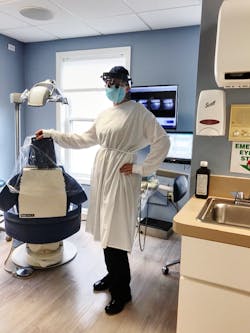Working in the age of COVID-19: Think like a virus
As we return to work and begin to grapple with the new policies, procedures, and—yes—all that added PPE, dental hygienists and the entire dental team must learn to cope within new boundaries that COVID-19 has created for dentistry. To be successful, stay safe, and provide the optimum care for our patients, it is important that dental health-care workers (DHCW) reassess their current way of thinking.
For years, we have rightly based our infection control on what we know to be the most resistant form of life, the bacterial spore.1 Now we are living in the age of COVID-19. While continuing to follow infection control procedures that are tried and true, we must now add a new dimension to our infection control armamentarium. How can we do this successfully? We must think like a virus! Take what we already know about viruses and add this to our processes.
So what do we know? Well, we understand that viruses are much smaller than bacteria. They are dynamic. They require a susceptible host. They have specificity, and they are infectious.1 Understanding these simple factors can greatly assist us in combating this new adversary. This just may be our greatest moment! We have the opportunity to begin again. Be innovative by utilizing our knowledge from the past and enhancing it with new protocols to keep our patients and staff better protected.
Mutation
Viruses are dynamic. Viruses are crafty and will mutate to survive.2 Therefore, we also need to mutate. Humans are creatures of habit. All too often we get comfortable with what we know, and we fear change. Think like a virus! Due to the minute size of viral microorganisms, our level 3 surgical masks alone are no longer our best line of defense. We recognize that these small particles linger in the aerosols created during our dental procedures. They remain present possibly for up to several hours beyond the time of dental treatment. Therefore, we are beginning to mitigate the virus by adding N95 masks, face shields, long gowns, filtration systems, and more efficient use of the HVE. We have front-desk personnel prescreening patients and taking temperatures at the door. We stagger appointments and work to minimize patient-to-patient contact.3 We are “mutating” to work safely within new boundaries established by COVID-19. If we can “mutate” like a virus, we can better defend ourselves and our patients. Keeping an open mind and consistently striving to adapt and change to new situations will allow DHCWs to thrive successfully in this new and challenging environment. Accept the change. Recognize that change is not an obstacle; it’s a method toward advancement. When we find a new challenge, innovate! Create a way around it.
Specificity
If we are to think like a virus, then we need specificity. Don’t be afraid to try various types of PPE. There are several types of face shields. Search for one that works well for you. If suitable shields are difficult to obtain right now, don’t be afraid to make your own modifications. Make sure your N95 fits correctly. Take measures to ensure you have the proper PPE to meet your specific needs. One size may not fit all. Every office is different. The location of the practice, size of the office, and the floor plan may impact how guidelines can be properly followed. Create protocols to meet the specific needs of your office and be open to adjusting processes along the way.
Latency
Viruses have an ability to remain dormant within their host cell for up to 25 years or longer before reactivating. A virus will wait years for an opportunity.4 If we are to think like a virus, then we need to have patience. We are living and working in difficult times. Don’t allow the stress to distract you from your professional responsibilities. We need to be kind to one another. Understand that all DHCWs are working under tremendous pressure. We need to support one another. Don’t give up. Recognize that although change is difficult, it is necessary. It will make our profession and our world a safer place in the future. Be patient. We will find a new sense of normalcy. Until we reach that point, be proactive, not reactive.
Become infectious!
If we are to think like a virus, then we too must become infectious! Spread dental knowledge. Infect your patients with what you know. Increase oral hygiene instruction. Consider home products that may help patients manage better at home during times when it may be necessary to quarantine. Stress to patients the very real connection between oral health and systemic health. Make patients aware of the importance of maintaining oral health to prevent diseases such as diabetes, heart disease, respiratory illnesses, and other conditions that may increase the risk for COVID-19. Infect your practice with your highly trained skills. Lead by example. Spread your enthusiasm for dental health. Our willingness to implement safety measures within the practice can demonstrate to others the importance of safety. Spread cleanliness. If you are not part of the solution, then you just may be part of the problem. Be infectious!
Many hygienists say they are “hands-on learners.” It doesn’t get any more hands-on than this. We are learning about COVID-19 by living it. Be open to change. Spread enthusiasm for oral health. Be an innovator. If something isn’t working quite right, don’t complain about it. Find a solution. Think like a virus! How can you adjust to your new environment? How will you meet challenges head on? Welcome change, and infect patients with knowledge and safe practices.
References
- Miller CH. Characteristics of microorganisms. In: Infection Control and Management of Hazardous Materials for the Dental Team. Elsevier/Mosby; 2016:10-16.
- Crosta P. What to know about viruses. Med News Today. May 30, 2017. Accessed June 23, 2020. https://www.medicalnewstoday.com/articles/158179
- CDC releases interim reopening guidance for dental settings. Centers for Disease Control and Prevention. Updated June 18, 2020. Accessed June 23, 2020. https://www.cdc.gov/oralhealth/infectioncontrol/statement-COVID.html
- Bird D, Robinson D. Microbiology. In: Modern Dental Assisting. 13th ed. Elsevier; 2020: 245-253.
- Oral health. Centers for Disease Control and Prevention. June 16, 2020. Accessed June 23, 2020. https://www.cdc.gov/oralhealth/index.html?CDC_AA_refVal=https%3A%2F%2Fwww.cdc.gov%2Foralhealth%2Findex.htm
Carolyn L. Patenaude, MSEd, BS, RDH, CDA, has 31 years of clinical experience in a general practice setting. She is an adjunct instructor at Tunxis Community College in Farmington, CT. She provides both clinical and didactic instruction for first- and second-year dental hygiene students and dental assisting students. She enjoys reading, hiking, and spending time with her husband and two sons.

